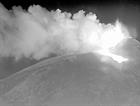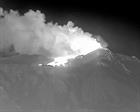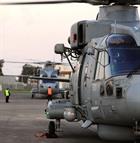Royal Navy helicopter captures Mount Etna eruption
The eruption of Mount Etna did not stop a team of Royal Navy aviators on their hunt to find ‘enemy’ submarines on a NATO exercise near Italy.
As Europe’s tallest active volcano spewed out its flow of lava, a pair of Royal Navy helicopter crews were searching the sea in the shadow of Mount Etna on a NATO submarine hunting exercise.
After their successful mission to find and hypothetically destroy the Spanish submarine, which was playing the enemy in the exercise yesterday, the helicopters from 814 Naval Air Squadron flew past Mount Etna and captured imagery of the volcano on their infra-red cameras which are normally used to search out enemy contacts at night.
“We know the equipment and sensors that we use to find and track submarines on our Merlin helicopters are world class, but this shows the level of clarity too,” said Chief Petty Officer Aircrewman Ian Macmeikan, who collected the images as the helicopter returned to base.
“I’ve used the infra-red cameras to find all sorts of ships and submarines on the surface of the sea or under it, but I’ve never seen it pick up an erupting volcano before.”
At this time the recent eruption poses no risk to the exercise, but we will of course remain vigilant to the unpredictable nature of this volcano. Incredibly, some of our crews caught today’s eruption on our infra-red cameras while they were out hunting submarines under the shadow of Etna.
Commander Brendan Spoors
The team has travelled from their home base of Royal Naval Air Station Culdrose, in Cornwall, to take part in the biggest annual submarine hunt in the Mediterranean. The squadron, affectionately known as the Flying Tigers, are flying from Sigonella Naval Base in Catalina, with Mount Etna ever brooding in the background. Working closely with ten other nations, they are taking part in NATO’s Exercise Dynamic Manta 2017 in the waters around Sicily.
Yesterday, and for the week ahead, submarines, ships and aircraft took turns to play hunter and hunted in a variety of war fighting scenarios in the shadow of Mount Etna. The aim of the exercise is to challenge the anti-submarine and anti-surface warfare skills of the different nations involved.
Dynamic Manta gives the Royal Navy team a fantastic chance to pitch their Merlin helicopters – arguably the world’s most advanced anti-submarine helicopter – against some of the most advanced submarines. Everyone taking part is hoping the latest behaviour of the unpredictable volcano nearby will not get in the way.
“Royal Navy aviators and engineers from 814 and 829 Naval Air Squadrons are monitoring the situation carefully after the recent eruption from Mount Etna,” said Commander Brendan Spoors, Commanding Officer of 814 Naval Air Squadron.
“Our NATO hosts in Sicily are giving us the most up-to-date information regarding the meteorological conditions that may affect our Merlin helicopters and they have a wealth of experience in this matter as you would expect.
“At this time the recent eruption poses no risk to the exercise, but we will of course remain vigilant to the unpredictable nature of this volcano. Incredibly, some of our crews caught today’s eruption on our infra-red cameras while they were out hunting submarines under the shadow of Etna.
"My team will continue to train alongside our NATO allies to make sure we are able to deliver protection from the threat of submarines to UK ships and our allies, wherever they may be in the world.”
The squadron’s engineers are keeping a watchful eye on the helicopters when they return from each mission – in particular looking for dirty hands.
“Volcanic ash can be very dangerous should it get into an aircraft’s engine,” said Warrant Officer Ian Morcom, 814 NAS’s Senior Maintenance Rating.
“Therefore in light of Etna’s current activity, we will be ready to react should an ash cloud develop near the area we are operating in. The engineers are keeping their eyes out for any deposits of volcanic ash on the helicopters – the best way of telling is to look at the colour of their hands after working on the helicopter and see if they are black.
“As a precautionary measure, we will carry out additional washes of the engines to ensure safe flight. This kind of thing is not unusual for us, we are used to reacting quickly to different operating conditions and weather.”
Today the squadron will fly another mission with the other NATO countries, but with one eye on the volcano. It is all valuable experience – they have to be ready to react at short notice, and protect Royal Navy and NATO task groups anywhere in the world.




